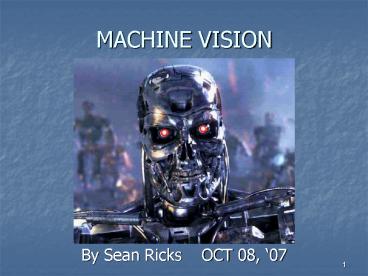MACHINE VISION - PowerPoint PPT Presentation
1 / 16
Title:
MACHINE VISION
Description:
'Machine vision is the capturing of an image (a snapshot in time), the conversion ... Machine Vision is found in many different aspects of automation ... – PowerPoint PPT presentation
Number of Views:416
Avg rating:3.0/5.0
Title: MACHINE VISION
1
MACHINE VISION
- By Sean Ricks OCT 08, 07
2
What is Machine Vision?
- Machine Vision is the application of computer
vision to industry and manufacturing. - Machine vision is the capturing of an image (a
snapshot in time), the conversion of the image to
digital information, and the application of
processing algorithms to extract useful
information about the image for the purposes of
pattern recognition, part inspection, or part
positioning and orientation.Ed Red
3
Typical Requirements
- One or more digital or analog camera
(black-and-white or color) with suitable optics
for acquiring images - Camera interface for digitizing images (widely
known as a "frame grabber") - A processor (often a PC or embedded processor,
such as a DSP) - (In some cases, all of the above are combined
within a single device, called a smart camera). - Input/Output hardware or communication links
- Lenses to focus the desired field of view onto
the image sensor. - Suitable, often very specialized, light sources
(LED illuminators, fluorescent or halogen lamps
etc.) - A program to process images and detect relevant
features. - A synchronizing sensor for part detection (often
an optical or magnetic sensor) to trigger image
acquisition and processing. - Some form of actuators used to sort or reject
defective parts.
4
Current State
5
Major Vendors of Machine Vision
- Sony
- Basler
- Stemmer Imaging
- Lumenera
- Aegis
- Scorpion
- E2v
- Keyence
- Soliton
- Cognex
- many many more
6
Important Rules
- Segmentation Define and separate regions of
interest - Thresholding Convert each pixel into binary (B
or W) value by comparing bit intensities - Edge detection Locate boundaries between
objects - Feature extraction Determine features based on
area and boundary characteristics of image - Pattern recognition Identify objects in midst
of other objects by comparing to predefined
models or standard values (of area, etc.)
Image taken from www.solitontech.com
7
Specifications
- Image Sensor
- of Total Pixels
- Lens Type
- Angle of View
- Minimum Object Distance
- Minimum Illumination
- Inspection Rate
- Focusing System
- Data Format
- Video Output
- Operating Temperature
- Power Consumption
- Dimensions
- Mass
- AE Control
- Camera Control Interface
8
Cost
- Program example Vision Builder AI and PCI-1410,
High Performance,4-channel, mono - Dev Kit - Vision Builder AI Development Kit
- Cables and Mounts
- Camera
- Lighting - LED ring light with constant current
source
- 2000.00
- 1000.00
- 300.00 - 600.00
- 1200.00 5000.00
- 1000.00
- TOTAL 5500.00 - 9600.00
Data courtesy of national instruments www.ni.com
9
Example
- A video camera has a 640 x 480 pixel matrix
(VGA). Each pixel must be converted from an
analog signal to the corresponding digital signal
by an ADC. The analog-to-digital conversion takes
0.1 microsecond (0.1 x 10-6 sec) to complete,
including the time to move between pixels. How
long will it take to collect the image data for
one frame, and is this time compatible with
processing at the rate of 30 frames per second?
10
Example
- A video camera has a 640 x 480 pixel matrix
(VGA). Each pixel must be converted from an
analog signal to the corresponding digital signal
by an ADC. The analog-to-digital conversion takes
0.1 microsecond (0.1 x 10-6 sec) to complete,
including the time to move between pixels. How
long will it take to collect the image data for
one frame, and is this time compatible with
processing at the rate of 30 frames per second? - There are 640 x 480 307,200 pixels to be
scanned and converted. The total time to
complete the analog-to-digital conversion process
is - (307,200 pixels)(0.1 x 10-6 sec) 0.0307 sec
- At a processing rate of 30 frames per second,
the processing time for each frame is 0.0333 sec,
which is longer than the 0.0307 sec required to
perform the 307,200 analog-to-digital
conversions.
11
Applications
- Color Camera Machine Vision Application
- http//www.solitontech.com/videos.htm
- Dimensional measurement
- Object verification
- Proper position/orientation
- Flaws and defects
- Counting
- Guidance and control (offsets, tracking)
- Inspection of pre-manufactured objects (e.g.
quality control, failure investigation) - Visual stock control and management systems
(counting, barcode reading, store interfaces for
digital systems) - Control of Automated Guided Vehicles (AGVs)
12
Cutting Edge
- Machine Vision being used to do difficult tasks.
- Combining the camera to the P.C.
- Infrared Machine Vision for surveillance
13
Cutting Edge Infrared Surveillance
Technical Paper taken from http//www.machinevisi
ononline.org/public/articles/articlesdetails.cfm?i
d3318
14
Summary
- Machine Vision is found in many different aspects
of automation - Machine Vision components have many different
specifications for your needs - You need to take into consideration cost of
components - Machine vision is a growing technology being
expanded to use not only in the commercial
sector, but is being prepped for use in the
private sector
15
Sources
- http//bssc.sel.sony.com/BroadcastandBusiness/Disp
layModel?m10005p2sp18id87846navidseeing_i
s_believing_with_sonys_new_ultra_high_5_mega______
___ - http//bssc.sel.sony.com/BroadcastandBusiness/mark
ets/10005/docs/irvs_SHAFI_6.5.07.pdf - http//www.solitontech.com/
- Demant C., Streicher-Abel B. and Waszkewitz P.
(1999). Industrial Image Processing Visual
Quality Control in Manufacturing.
Springer-Verlag. - http//www.machinevisiononline.org
16
Questions?

